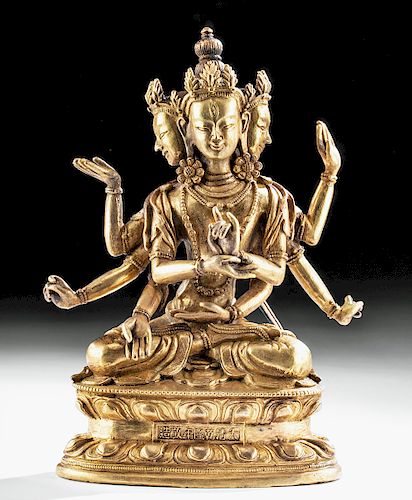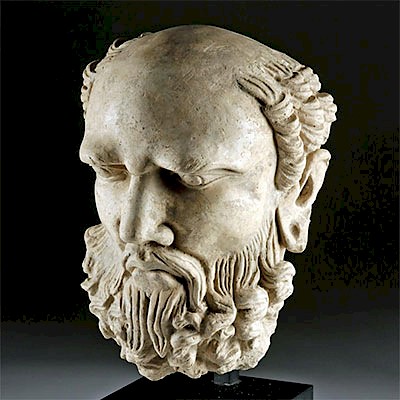Sealed Chinese Qing Gilt Brass Statue of Ushnishavijaya
Lot 201
About Seller
Artemis Fine Arts
686 S Taylor Ave, Ste 106
Louisville, CO 80027
United States
Selling antiquities, ancient and ethnographic art online since 1993, Artemis Gallery specializes in Classical Antiquities (Egyptian, Greek, Roman, Near Eastern), Asian, Pre-Columbian, African / Tribal / Oceanographic art. Our extensive inventory includes pottery, stone, metal, wood, glass and textil...Read more
Categories
Estimate:
$2,500 - $5,000
Absentee vs Live bid
Two ways to bid:
- Leave a max absentee bid and the platform will bid on your behalf up to your maximum bid during the live auction.
- Bid live during the auction and your bids will be submitted real-time to the auctioneer.
Bid Increments
| Price | Bid Increment |
|---|---|
| $0 | $25 |
| $300 | $50 |
| $1,000 | $100 |
| $2,000 | $250 |
| $5,000 | $500 |
| $10,000 | $1,000 |
| $20,000 | $2,500 |
| $50,000 | $5,000 |
| $100,000 | $10,000 |
| $200,000 | $20,000 |
About Auction
By Artemis Fine Arts
Jan 16, 2020
Set Reminder
2020-01-16 10:00:00
2020-01-16 10:00:00
America/New_York
Bidsquare
Bidsquare : Ancient | Asian | Ethnographic
https://www.bidsquare.com/auctions/artemis-gallery/ancient-asian-ethnographic-4799
Featuring classical antiquities, ancient and ethnographic art from cultures encompassing the globe. Artemis Fine Arts info@artemisgallery.com
Featuring classical antiquities, ancient and ethnographic art from cultures encompassing the globe. Artemis Fine Arts info@artemisgallery.com
- Lot Description
East Asia, China, Qing Dynasty, 19th century CE. A gilded brass sculpture of the Buddhist deity Ushnishavijaya, the goddess of long life, depicted sitting upon a double lotus throne and presenting three faces and eight hands. In addition to presenting an impressive form, this hollow cast sculpture is sealed with copper inscribed wth a lotus motif on the bottom. The contents of such statues traditionally include holy articles of some type. Beyond this, Ushnishavijaya sits in a vajra posture and is elaborately dressed in silks and bejeweled ornaments. Size: 7.25" H (18.4 cm)
Given the presence of the copper seal, this statue was likely created for religious practices. When such figures are consecrated, the image is first purified in order to be deemed suitable for the inhabitance of Buddha or another deity, in th is case Ushnishavijaya. Then the statue is invested with the presence and power of that deity. Unless it has been consecrated, a statue is not considered suitable for use in religious practices. Holy articles are sealed inside.
Ushnishavijaya is traditionally described as the "color of the autumn moon" with her three faces being white, yellow, and blue - each face with large eyes- and eight hands. In her hands she customarily holds a visvavajra (first right hand), a white lotus with Amitabha residing (second), an arrow (third), and the fourth assumes a gesture of generosity. In the first hand on the left is a vajra lasso, then a bow in the second, the third offers protection, and the fourth holds a nectar vase in a meditative pose
Provenance: private Hawaii, USA collection; ex J. Ducosin collection, Hawaii, before 2008
All items legal to buy/sell under U.S. Statute covering cultural patrimony Code 2600, CHAPTER 14, and are guaranteed to be as described or your money back.
A Certificate of Authenticity will accompany all winning bids.
We ship worldwide and handle all shipping in-house for your convenience.
#151862Statue is in excellent condition save minor age wear. There is a copper seal on the underside of the base, suggesting that it may contain holy articles.Condition
- Shipping Info
-
All shipping is handled in-house for your convenience. Your invoice from Artemis Gallery will include shipping calculation instructions. If in doubt, please inquire BEFORE bidding for estimated shipping costs for individual items.
-
- Buyer's Premium



 EUR
EUR CAD
CAD AUD
AUD GBP
GBP MXN
MXN HKD
HKD CNY
CNY MYR
MYR SEK
SEK SGD
SGD CHF
CHF THB
THB
















